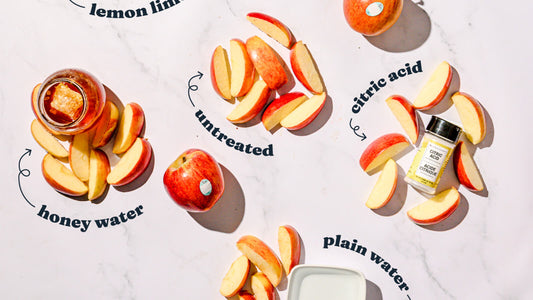You’ve no doubt read it time and time again in recipes to “peel and core” apples before continuing with the rest of the process. Yes, the flesh of an apple is its most versatile, tasty, and familiar part. But by neglecting its other components, we’re missing out on valuable nutrients and wasting more than is necessary.
Today I’m going to teach you how to harness the power of the apple in its entirety. It is Earth Day, after all! Let’s first dive into what makes an apple tick and then some recipes that let those underdog ingredients shine.

What Are the Different Parts of the Apple?
As with most fruit, apples are composed of several different parts, each with their own purpose and nutritional benefit. Let’s break down the anatomy of an apple, working from the outside-in, to better appreciate the potential of its underutilized parts!
First, technically, we have the stem of the apple. While often ignored and discarded for its lack of taste, the stem is bound to the core, holding everything together and anchors the apple to the tree as it grows. If ever juicing an apple, consider using the stem (and seeds) for a little boost in iron and fiber.
Moving right along, we have the skin, which acts as a sort of shield, helping to protect the inner flesh and prolong the life of an apple. It’s packed with fiber and Vitamins A, C, and K.
Peeling back the skin (see what I did there?), we arrive at the pulp or flesh. The pulp is what most people are used to baking with. It contains more Vitamin C and the apple’s pectin, a starch naturally present in most fruits that provides structure and helps jams set when heated.
Lastly, we arrive at the apple core, which contains the seeds. Contrary to what you might think, apple seeds are safe to consume in moderation, but are often thrown aside due to their bitter taste.
Now that we have a firmer grasp on what makes up the entire apple and the important role each part plays, let’s dive into the different ways you can bake with every part of the apple!
1. How to Bake with Apple Skin
The most obvious, and, truthfully, the tastiest way to utilize the skin of an apple is to dehydrate the peels and make some apple peel chips. Are you looking to avoid the hassle of dehydrating (I hear you!)? Try baking up these roasted apple chips from Kitchn instead, then toss them in cinnamon sugar—yum!
Some easier ways would be to throw those apple peels into your favorite fruit smooth for some added fiber or even over a salad as a little topper. Keep the skin on when you try this Apple & Cabbage Slaw with Miso Dressing!
2. What to Bake with Apple Flesh
Here’s the one we’re most familiar with, right? There’s truly no shortage of ways or recipes to use the apple flesh. Some of my favorites are this Apple & Goat Cheese Tart with Fig Jam or this Flaky Apple & Almond Cream Galette!
A note on using apple flesh for pies or pastry: as I mentioned before, apple flesh is high in pectin and is what keeps the apple firm, but there is one caveat. As an apple ripens, it naturally loses some of its pectin, causing things to soften. This creates the ideal texture for pies, but not so great for holding sauces or fillings together.
This is why you need to add a thickening agent (like cornstarch or flour) when baking an apple pie—to counter the loss of pectin. This allows you to maintain that balance of tenderness and structure, while making sure your filling doesn’t resemble soup. We’ve all been there!
3. Can You Bake with Apple Cores or Seeds?
Certainly! Since the core contains those pesky little seeds, it’s often discarded to avoid working around their removal. The seeds, again, are safe to eat. You may find them bitter, but that doesn’t mean there aren’t recipes out there to help mask this quality.
Just like the peels, you can cut your apples into thin slices all the way through the core and bake some apple chips. Feel free to leave the seeds in or remove them. Or even this Apple & Rosemary Focaccia!
Here’s one you've never heard of: apple core syrup. This would be great in a cocktail or over some buttermilk pancakes. Quite literally drooling over here!
4. Recipes That Use the Entire Apple
While they may be few and far between, there are in fact recipes that utilize the entire apple—an Earth Day dream! I’ve been eyeing this Apple Jelly by David Lebovitz that would be perfect to spread over toast and top with a little cheese.
There’s also this Classic Apple Cider that would be perfect for those chilly fall evenings. Another cozy treat is baked whole apples. This recipe calls for removing some of the core to make room for the filling, but it's still a great way to utilize most of the apple.
When all else fails, save the skin, core, and seeds to make Apple Scrap Cider Vinegar!

Committing to using the entire apple, or at the very least using more than just the flesh, is a great step towards reducing waste in the kitchen. Yes, composting is a great alternative, but it can also be fun to experiment with something new.
Here’s your Earth Day challenge—pick at least one part of the apple you’ve never baked with and give it a whirl. Who knows? Your new favorite recipe may be right here waiting for you! Happy baking, friends.





